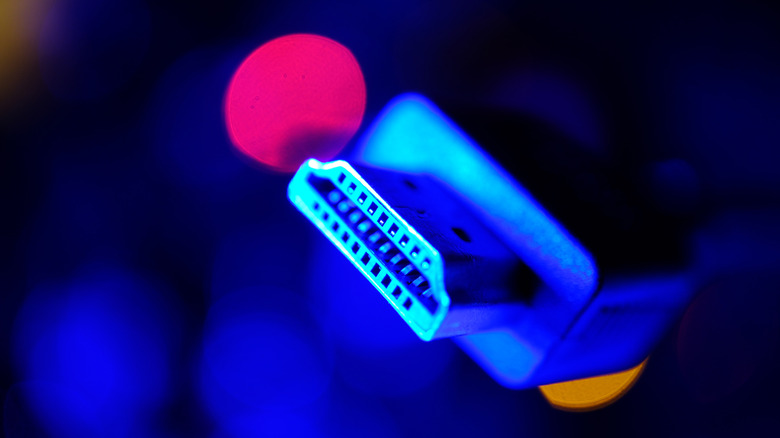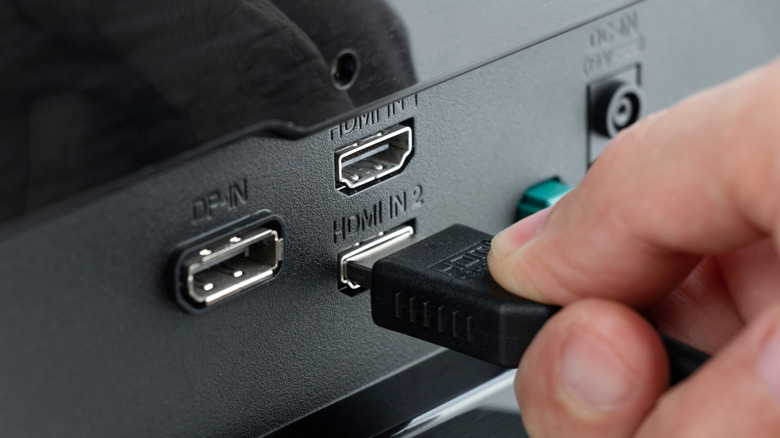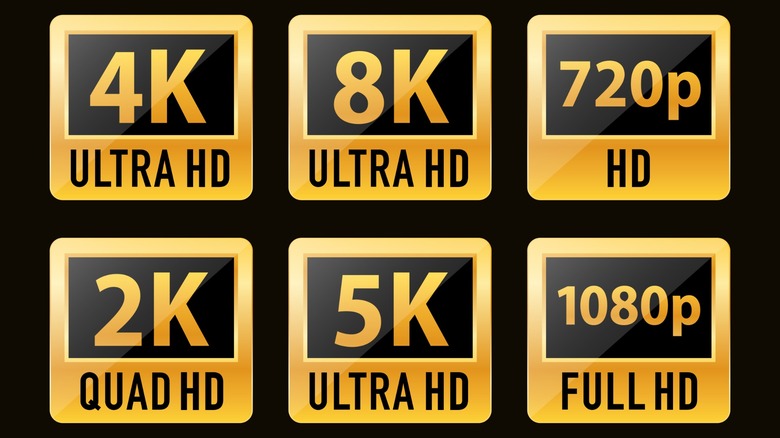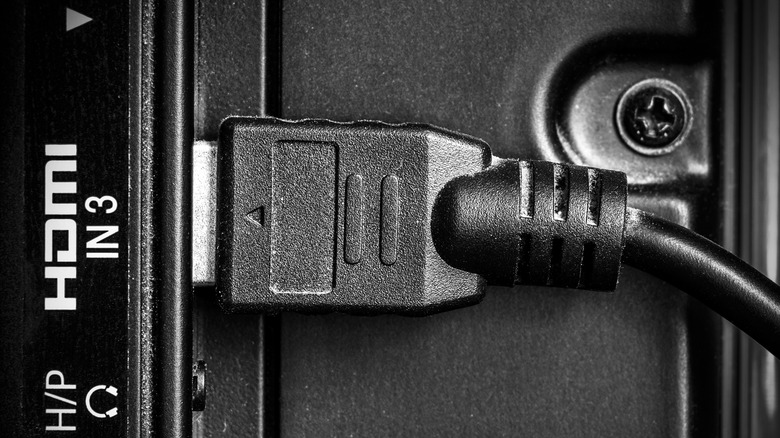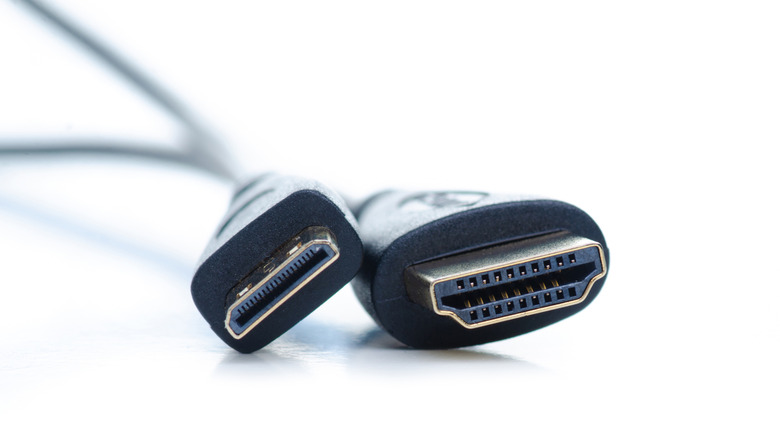What Does HDMI Stand For & What Does The Number After It Mean?
These days, most of us have at least one HDMI cable plugged into our TVs. The ubiquitous accessories started appearing when HD television sets were introduced to the consumer market. So, it should be no surprise that the "HD" in HDMI stands for the same thing as it does in HDTV—"high-definition." High definition is the standard resolution that improved upon the standard-definition resolution used by most TVs at the end of the 20th century, and it generally means a resolution of 720p or higher.
The full acronym HDMI stands for "High-Definition Multimedia Interface," and it does precisely that — serving as a transmitter of uncompressed digital signals from one source of audio/video to another. It was developed by TV and home media hardware developers Hitachi, Matsushita, and Sony because traditional connectors, like the red, white, and yellow RCA cables — which you may have used to attach your VCR to your standard-definition TV — could not support the higher resolution of the HD era.
The red and white RCA cables provided left and right audio signals for stereo, while the yellow cable transmitted the video signal. HDMI, on the other hand, carries both video and audio signals through a single cable — and, in some cases, Ethernet — using multiple pins at each end, streamlining the mess of cables you may have found behind your TV. When using or purchasing an HDMI cable, you may notice it has a number after it. These HDMI numbers refer to the maximum resolution and refresh rate a given cable can support and currently range from 1.0 to 2.2 as improved standards are developed. Since both resolution and refresh rate affect the picture quality of your TV, it's important to understand what each number signifies.
What is the maximum resolution and refresh rate of HDMI 1.0-1.4 cables?
The numbers designating an HDMI version don't refer to the maximum specs they provide but rather what they can support. For example, an 8K HDMI cable doesn't offer an 8K signal to just any device. In order to achieve 8K resolution, you'd need to connect both a device capable of outputting 8K and a television that can display 8K resolution with an HDMI cable that supports 8K. (You'll probably also need to check or adjust some picture settings in your TV's menu.)
Because of this distinction, HDMI cables are classified with official marketing names to avoid misleading consumers who are shopping for an HDMI cable. An HDMI 2.0 cable will be labeled on the box as "Premium High Speed," while HDMI 2.1 is called "Ultra High Speed."
HDMI 1.0 was the first cable introduced in 2002 and supports up to 1080p@60Hz, 8 audio channels, and up to 4.95 Gbps bandwidth. It does not support HDR.
HDMI 1.1 and 1.2, introduced in 2004 and 2005, respectively, support up to 1440p@30Hz and 4.95 Gbps bandwidth. These versions added support for DVD-Audio and One-Bit Audio but still do not support HDR.
HDMI 1.3 and 1.4 were introduced in 2006 and 2009, respectively, and support up to 10.2 Gbps bandwidth, Dolby TrueHD, and DTS-HD. Neither supports HDR, but HDMI 1.4 was the first version to support 4K, allowing up to 4K@30Hz. Additionally, HDMI 1.4 introduced an Audio Return Channel (ARC), which HDMI 1.3 does not support. HDMI 1.3 and 1.4 are marketed as "High Speed HDMI" or "High Speed HDMI with Ethernet."
What is the maximum resolution and refresh rate of HDMI 2.0/2.1 cables and the new HDMI 2.2 format?
If you're looking for the current standard for gaming and high-quality 4K video, you'll want to use HDMI 2.0 or higher, which was introduced in 2013. HDMI 2.0 is capable of 4K@60Hz or 5K@30Hz, 18 Gbps bandwidth, HDR, HE-AAC, DRA, and 32 audio channels. It's designated as Premium High Speed HDMI.
HDMI 2.1 debuted in 2017 and transmits up to 4K@120Hz or 8K@60Hz, making it the first 8K-capable HDMI cable. It also introduced the Enhanced Audio Return Channel (eARC). The eARC standard allows for enhanced audio bandwidth of up to 37 megabits per second, which is ideal for lossless, high-resolution surround sound. HDMI 2.1 supports HDR and has a maximum bandwidth of 48 Gbps. It is marketed as Ultra High Speed HDMI.
It was announced at CES 2025 that the newest standard — HDMI 2.2 — will debut later this year. HDMI 2.2 is set to provide a whopping 96 Gbps and will support 8K@240Hz. It will even be capable of supporting 12K and 16K, as well as 10K and 4K because — like all HDMI standards — it's backward compatible. HDMI 2.2 connectors will be designated as Ultra96 cables. If you're worried about having to go through the trouble of upgrading your home entertainment system, don't worry. The maximum resolution of HDMI 2.2 isn't really practical for standard TVs — most of us don't even own 8K televisions, let alone 16K. The only customers buying HDMI 2.2 cables at first will likely be those who own large, ultra-high-definition displays. The enhanced capabilities of HDMI 2.2 will also be useful as VR displays improve.
These numbers are not the same as the HDMI input numbers on your TV
Be careful not to confuse HDMI version numbers (like HDMI 2.0 or 2.1) with the input labels on your TV, such as HDMI-1 or HDMI-2. These designators, found on your TV's physical ports and in your menu settings, are just convenient labels that allow you to keep track of what devices are plugged into which input ports.
This can be especially useful if you have multiple devices connected to your television. By assigning "Input 1" to a particular device, such as a Blu-Ray player, you'll know exactly how to display that device using your remote control. You can also easily switch your display from your Roku Express 4K+ to your PlayStation 5, for example. (Most TVs come with two or three of these ports, but there are simple ways to add more HDMI ports to your TV.)
If you select HDMI-2 on your TV, you are going to display whatever is plugged into your second HDMI port. This does not mean you'll be getting the benefits of an HDMI 2.0 cable that can provide 4K — they're two completely different labels. So, if you're wondering why you don't suddenly get 4K on your 1080p television when you select HDMI-2, that's why. You'll need a 4K television, a 4K-capable device, and an HDMI cable capable of 4K resolution or higher plugged into the HDMI port to achieve this.
HDMI cables are also classified by letters
Different HDMI cables are also classified by letters, with these designations having a completely different meaning from numbers — HDMI 1.0 does not equate to HDMI Type A, for example. Instead of categorizing HDMI by its maximum resolution and frame rate capabilities, letters refer to the size of an HDMI cable's ends and how many pins are in its connectors. An HDMI cable can be 1.0 or 1.4 and still be a Type A, as letter designations don't correspond directly to HDMI versions.
Type A is the standard and most common HDMI cable available. It uses a 19-pin configuration and is commonly used to connect TVs to devices such as cable boxes, DVD and Blu-Ray players, game consoles, streaming sticks, and projectors. The Type C standard also uses 19 pins, but it is physically smaller than a Type A HDMI port/cable on one end. Its other end is the same standard size as Type A HDMI. Type C is called Mini HDMI and supports HDMI 1.3 and higher. It is typically used for smaller devices like tablets, DSLR cameras, and certain laptops. Since it has a standard size on one end, it can connect such devices to televisions or external monitors with the usual Type A HDMI port.
Similarly, Type D, which is also called Micro HDMI, performs the same function but with an even smaller 19-pin footprint on one end. Type D HDMI is used for even smaller devices, like mini tablets, smartphones, and certain digital cameras. Type D cables support HDMI 1.4 or higher.
There are other types of HDMI, but they're less common
When classified by letters, there are also a couple of less common but useful HDMI variants. Type B HDMI, also known as Dual Link HDMI, has 29 pins and can transmit DVI-D video. While it came out in 2002 with the launch of the original HDMI standard, it was rarely used and has long since been obsolete, as HDMI 1.3 provides the same capabilities with even faster speeds.
Type E HDMI cables are used in vehicles, which is why they're rarer than Type A, C, or D. Like those standards, Type E has 19 pins and provides the exact resolution and other specs — it is compatible with HDMI 1.4 or higher. However, Type E uses a specialized locking tab that keeps it secure, even with the constant vibration that comes with a moving vehicle. Type E HDMI ends also have a hard shell to better shield them from dust, dirt, and moisture. It can be used if you have a video player in your car for children or if you often work with a computer in your vehicle.
